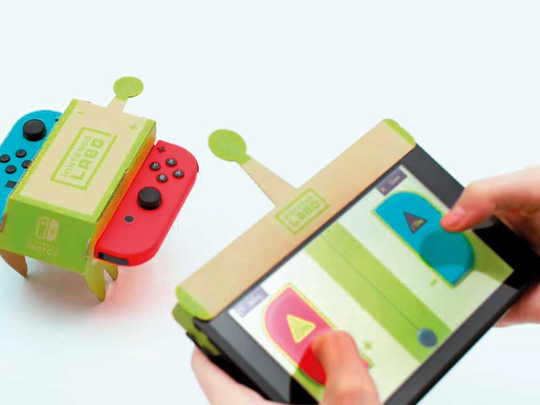
The soaring success of the Nintendo Switch, the Japanese gaming giant’s most recent console, has all but banished the woes of a turbulent few years for the business.
The hybrid device, which can be hooked up to a TV or used on the go, has outstripped even its creator’s expectations, selling almost 15 million units between its release in March last year and the end of 2017. This was enough to smash the lifetime sales of its disastrous predecessor, the Wii U, return the company to a healthy profit, send its share price to a 10-year high and put Nintendo back at the forefront of the gaming industry.
However, when the console was first unveiled, critics and industry observers were cool on the idea. Nintendo’s share price dropped and its line-up of games was seen as too sparse to excite the market.
It was only once consumers got it into their hands that the Switch’s appeal became obvious, says Shinya Takahashi, the Nintendo executive in charge of the console. “Explaining [the Switch] verbally wasn’t really that effective, but after the launch and several games, people actually got to experience it and take the system outside of their house and they realised what type of experience that is,” says Takahashi, whose official title is general manager of entertainment planning and development.
A slew of critically acclaimed exclusives, including the latest Legend of Zelda and Super Mario titles, allied with a steady stream of titles from third-party publishers and independent developers meant the Switch’s library filled up quickly.
Combined with the ability to take the machine on the go and the idiosyncratic charm of its detachable “Joy-Con” controllers, the console became an alluring prospect and a breath of fresh air compared to high-powered competitors from Sony and Microsoft.
But as the Switch enters its second year, Nintendo needs to branch out beyond the traditional gamers it has deliberately courted thus far. Its library of recognisable games will continue to grow, with fan favourites Super Smash Bros and Pokemon due to be released this year, but it has always had a reputation for lateral thinking and family-friendly appeal.
Nintendo is combining these with its next project, known as Labo. Using a collection of cardboard sheets, assembled at home and attached to either the Switch console itself or its controllers, gamers can create a range of technology-powered toys, or “Toy-Cons”. These include a remote-controlled car driven entirely by the vibration of the controllers, a fishing-rod powered by motion, a fully functioning piano that uses wireless sensors to recognise key presses and a robot suit that uses a combination of string, pulleys and sensors to control a mechanoid on screen.
It is the sort of invention that only Nintendo would have conceived, let alone produced. But its genesis was a happy accident, says Takahashi. “When we were considering what kind of attachments we could put on to the controllers to take advantage of the features, it was cardboard we used for trial and error.
“Initially, we were trying to find attachments we could make as products, but we realised this process of assembling and creating attachments was fun too, so we thought maybe as a product we should encompass everything from building, to discovering and playing.” Similar to products such as the Wii Fitness Board, Labo is the kind of quirky, clever add-on that only a confident Nintendo would produce in order to expand its audience.
Elsewhere, the company is building theme parks within Universal Studios in Japan and the US, due to open in 2020, and is teaming up with Minions creator Illumination Entertainment to make a Super Mario Bros movie. Back in the gaming industry, Nintendo is also stepping up its interest in developing mobile apps. It has already found significant success with titles such as Super Mario Run and Animal Crossing, which Takahashi hopes will drive interest in Nintendo’s dedicated gaming systems among the billions of smartphone users on the planet.
He says: “With the release of Super Mario Run and Animal Crossing, we have seen the trend of people remembering our titles, so we have seen an increase in sales.”
Nintendo was criticised for entering the lucrative world of smartphone apps too late, due to an apparent reluctance to compromise, and its eventual entry has seen it dabble in the controversial trend of micro transactions and “loot boxes”, in which gamers pay for minor upgrades.
The practice is a growing source of revenue for gaming companies, but has been likened to gambling, and raised concerns that it was exploiting children.
Takahashi says he recognises the responsibility Nintendo — known for its family-friendly nature — has with micro transactions, but that the company has a simple test when using them.
“We always kept in our mind that the products we release should not be disliked by mothers,” Takahashi says. “We understand what other companies do with micro transactions, and I should not completely deny that we do micro transactions. But we will do ‘Nintendo-style’ micro transactions. In a way that mothers will not dislike.”
Whether it is micro transactions, traditional games or quirky cardboard toys, Nintendo tends to do things its own way.
But the company is also reaping the benefits of a wider resurgence in games consoles, with its competitors PS4 and Xbox One also defying predictions that mobile games would lead to falling sales. “We have seen the trend of very strong mobile games in the past but now home console games are regaining presence in the market,” says Takahashi. “It isn’t only about Nintendo, the video game industry all doing well is something that makes me very happy.”








